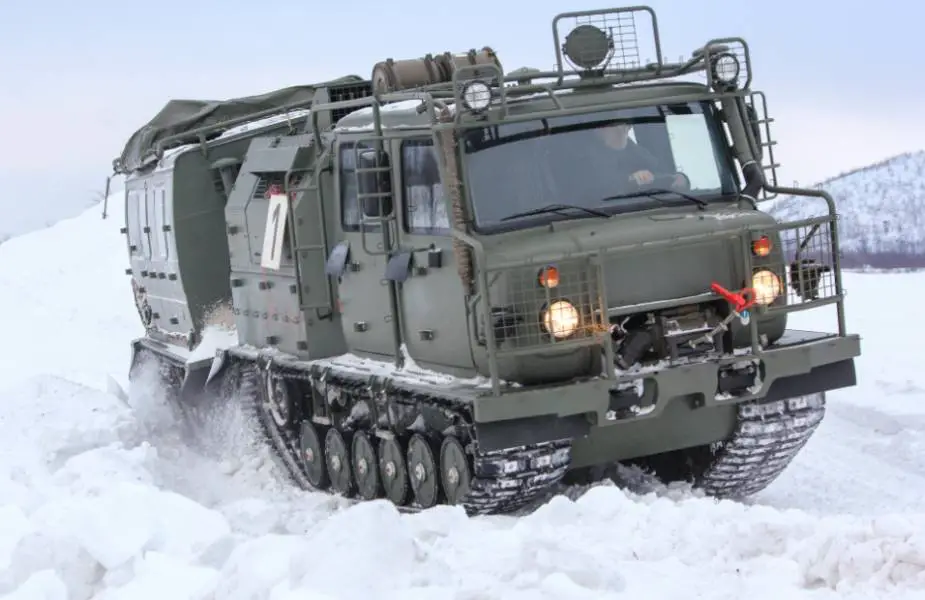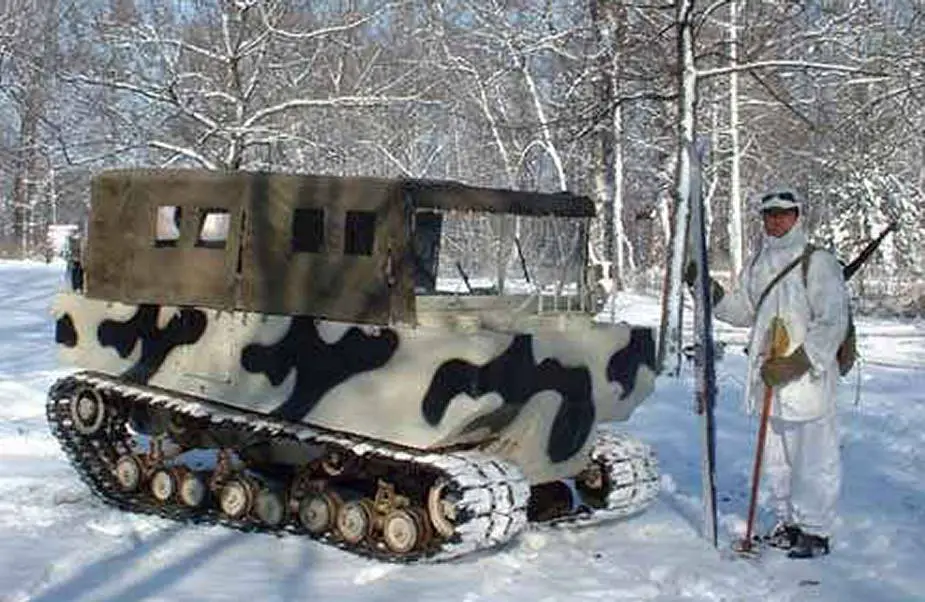Breaking news
Russian tank unit in Buryatia receive Aleut articulated amphibious vehicles.
The tank formation of the Eastern Military District’s air defense forces in Buryatia received two-link tracked floating snow and swamp-going vehicles of high cross-country ability GAZ-3344-20 "Aleut".
Follow Army Recognition on Google News at this link

GAZ-3344-20 Aleut (Picture source: Russian MoD)
The Aleut all-terrain vehicle is made according to a modular scheme: the front link is an energy module in which 5 people can be transported, including the driver; the payload was 2,500 kg. "Aleut" got its name from the Aleutian islands (let's notice taht most of the Aleutian Islands belong to the U.S. state of Alaska, but some belong to the Russian federal subject of Kamchatka Krai.
The Zavolzhsky Crawler Vehicle Plant' GAZ-3344-20 consists of two tracked units linked by a steering mechanism. The vehicle weigt 11 tons. The payload of the first section is 750 kg, the second one is 2,250 kg. It may accommodate 12 people. The front vehicle is motorized with the Russian-made diesel engine YaMZ-5347-26. The vehicle can reach 50 km/h with a maximum cruising range of 450 km. It is also fully amphibious without any preparation and has a maximum speed on water of 3.8 km/h.
According to the manufacturer, Russian armed forces have ordered a total of 100 vehicles to be used in the Arctic region. The decision to propose these vehicles to the Russian military was made following a series of Arctic expeditions, including the stand-alone trip from Tiksi to the Kotelny Island (Novosibirsk Islands). The expedition ended in February 2017.

Studebaker M29 Weasel (Picture sources : Roberts Armory)
M29 Weasel, the U.S. predecessor dating back to Wolrd War 2
The idea for the Weasel came from the work of British inventor Geoffrey Pyke in support of his proposals to attack Axis forces and industrial installations in Norway. Pyke's plan to hamper the German atomic weapons development became Project Plough for which he proposed a fast light mechanised device that would transport small groups of commando troops of the 1st Special Service Force across snow. In active service in Europe, Weasels were used to supply frontline troops over difficult ground when wheeled vehicles were immobilised.
The first 2,103 vehicles designated as T15 and later categorized as the M28 Cargo Carrier had 15 in. (380 mm) Kégresse-style "rubber-band" style tracks, the later version designated as M29 had 20 in. (510 mm) tracks of the same format. The T15/M28 version had a completely different hull and a reverse drive line to the later M29 versions. The M29 was somewhat amphibious, but with a very low freeboard; the M29C Water Weasel was the more amphibious version, with buoyancy cells in the bow and stern as well as twin rudders. The M29C could not operate in other than inland waterway conditions, so its use in surf or rough water was very limited but did see action in the Pacific theatre. An easy way to distinguish the difference from an M28 and M29 is to look at the side track arrangement of bogie wheels.

A Norwegian tracked cargo carrier boards military personnel during Operation Alloy Express '82. (Picture source : Wikipedia)
Volvo Bandvagn 202, the first articulated tracked amphibious vehicle
Bandvagn 202 (Bv 202) is a tracked articulated, all-terrain vehicle developed by Bolinder-Munktell, a subsidiary of Volvo, for the Swedish Army. The vehicle is formed by two rubber Kegresse track units with a multi-directional pivot in between. The front unit contains the engine and gearbox through which power is delivered to the front and, via a propshaft in the pivot mechanism, the rear tracks. A hydraulic ram on the pivot "bends" the vehicle in the middle to steer it—there is no braking of track units for steering as on conventional tracklaying vehicles. The controls are a conventional steering wheel on the left hand front of the vehicle. It can reach a speed of 35 km/h on land and 7 km/h (4 kn) on water. The Bv 202 carries a driver and a commander in the front unit and 8–10 troops in the trailer unit. The Bv 202 was designed to transport troops and equipment through snow or boglands in the northern parts of Sweden. The last Swedish unit to use this vehicle was the Cavalry, who found that the manual gearbox Bv 202 was much quieter than the automatic transmission Bv 206.
Production started in Arvika in 1964 and ended in 1981. The Bv 202 has since been succeeded by the Hägglunds Bandvagn 206. The Mk1 Bv 202 is powered by an 82.5 bhp (61.5 kW) Volvo B18, the MK2 by the 97 bhp (72 kW) B20. It has less ground pressure than a skier and is fully amphibious. The Bv 202 was used by NATO forces, and replaced the older Swedish Snow Trac ST4 Over-snow Vehicle, which was employed by the British Royal Marines under NATO.



















